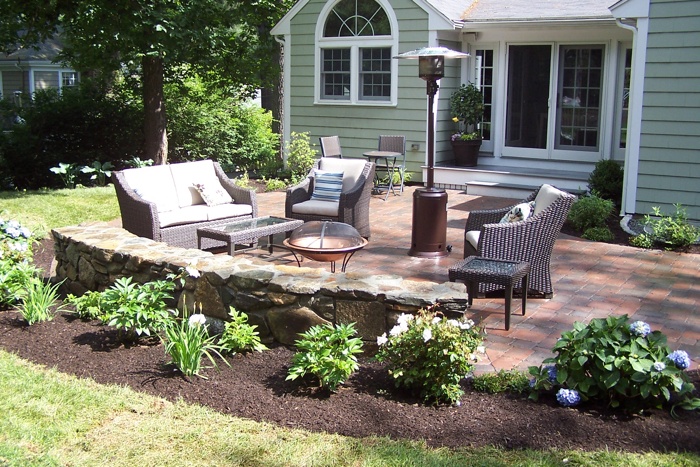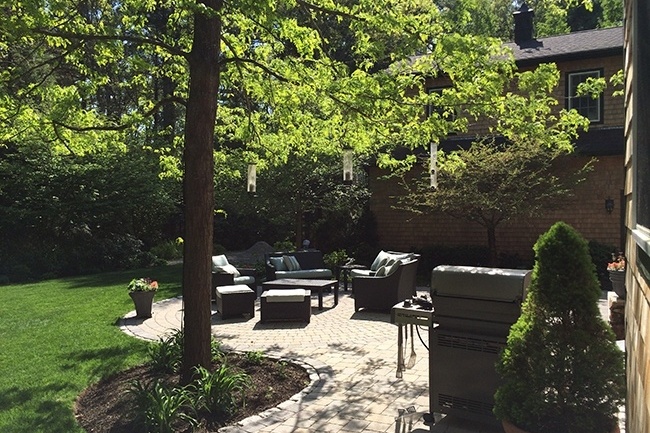One of the biggest mistakes to make when designing outdoor living spaces is to plunk things down wherever it seems easiest. These seemingly easy or convenient spaces may be exactly the wrong places to install landscape elements that you hope to incorporate into regular use. This is what we call “feature-scaping” – a practice that includes installing outdoor landscape features where it’s the least costly or the most convenient for construction.
Traditional landscape companies are often guilty of feature-scaping. Without much consideration being given to how the homeowner will actually interact with this feature or space, chances are good the placement and installation will be less than satisfactory in the long run and consequently won’t get used much.
So how do you properly size and place outdoor patios, kitchens, fire pits, and sitting areas?
The opposite of “feature-scaping” is something we call “Life-ScapingTM.” This landscape development strategy involves analyzing homeowner lifestyle and preferences and using that information to inform landscape design. It’s about ensuring that both inside and outside spaces work in harmony so that people and activities can naturally and easily flow between the two environments. It’s also about ensuring that the environmental aspects of the land are considered and respected with the solutions.

Here are three tips to help you properly place and size your outdoor living space:
1) Walk. Before you even begin looking outside, you need to start by thinking about the transition between indoor and outdoor spaces and where you’ll need to walk to get from here to there. If you pay as much attention to indoor/outdoor transitions as you do to the actual outdoor space, you might be surprised at what that tells you. The journey to a place is an important ingredient in the mood of that place when you get there. For example, if you like to cook and entertain, you don’t put your kitchen on one side of the house and your dining room on the other – that doesn’t make sense. Likewise, if you plan on doing a lot of cooking outside, you don’t want to site your patio, deck, or outdoor kitchen so that it’s difficult to access it from where you store food and cooking items in the house. You don’t want to have to carry trays of food through your living room to get to your grill outside. That will lead to repeated frustration that does little more than guaranty that your new outdoor space will be unsatisfactory.
2) Look. Once you understand how you’ll move from indoors to outdoors, it’s important to determine what you’ll see when you look out there. Using our kitchen example again, if you’re standing in your kitchen and looking through your indoor dining area to yet another dining area outside, doesn’t that seem repetitious and boring? Wouldn’t it make more sense to look from a dining area to an inviting place that you’d like to retreat to after a meal and enjoy an after-dinner drink or coffee and conversation? So instead of placing your outdoor dining area where you’re looking at yet another table and chairs, think about putting a cozy outdoor furniture set with soft cushions on a patio with ambient lighting for conversation where you and your guests will see it while eating indoors and anticipate a relaxing outdoor after-dinner activity.
3) Relax. And speaking of outdoor landscaping features, another big mistake homeowners make all the time is under-estimating the space they’ll need for a deck or patio. Most people build them to fit an unoccupied table and chairs. That’s simply wrong. To actively use and enjoy that space means sitting comfortably out there. For example, what happens when people are done eating? They push away from the table to stretch out their legs, relax and chat, taking up twice the amount of unoccupied space. If you haven’t planned for this more expansive use of your deck or patio, people will feel cramped and uncomfortable, so be sure to think of all the uses, the number so people, and the circulation around activities when you size your outdoor living areas.
As you can see, to optimize your outdoor living space – to create a “Life-ScapeTM”, not just a “feature-scape” – it’s important to consider everything that may affect your landscape design, including transitions, sight lines, and the actual amount of space you’ll need to relax.






Leave a comment